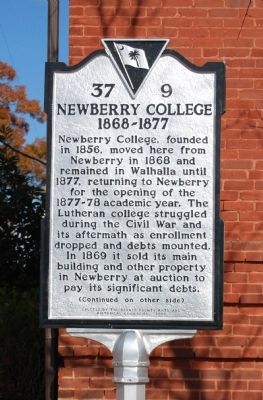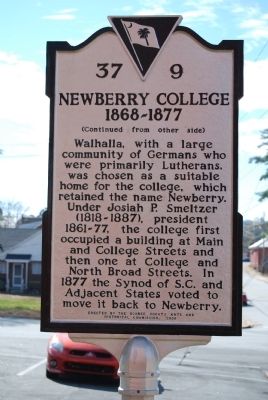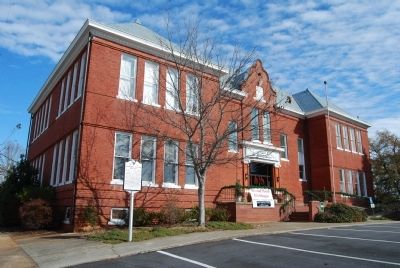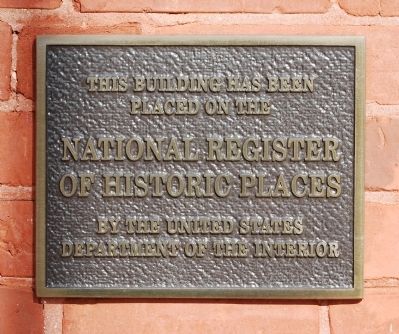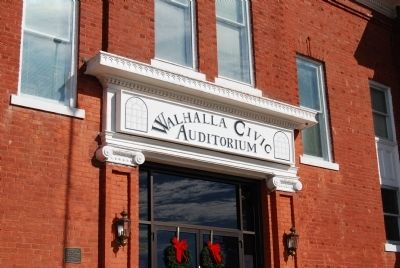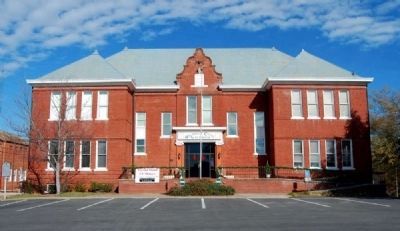Walhalla in Oconee County, South Carolina — The American South (South Atlantic)
Newberry College
1868-1877
[Front]:
Newberry College, founded in 1856, moved here from Newberry in 1868 and remained in Walhalla until 1877, returning to Newberry for the opening of the 1877-78 academic year. The Lutheran college struggled during the Civil War and its aftermath as enrollment dropped and debts mounted. in 1869 it sold its main building and other property in Newberry at auction to pay its significant debts.
[Reverse]:
Walhalla, with a large community of Germans who were primarily Lutherans, was chosen as a suitable home for the college, which retained the name Newberry. Under Josiah P. Smeltzer (1818-1887), president 1861-77, the college first occupied a building at Main and College Streets and then one at College and North Broad Streets. In 1877 the Synod of S.C. and Adjacent States voted to move it back to Newberry.
Erected 2006 by Oconee County Arts and Historical Commission. (Marker Number 37-9.)
Topics. This historical marker is listed in this topic list: Education. A significant historical year for this entry is 1856.
Location. 34° 46′ N, 83° 3.905′ W. Marker is in Walhalla, South Carolina, in Oconee County. Marker is on East North Broad Street, on the right when traveling north. Marker is located on the grounds of the old Walhalla Graded School. Touch for map. Marker is at or near this postal address: 101 East North Broad Street, Walhalla SC 29691, United States of America. Touch for directions.
Other nearby markers. At least 10 other markers are within walking distance of this marker. Duty, Honor, Country (approx. 0.2 miles away); The Silver Rose (approx. 0.2 miles away); Combat Infantrymen Monument (approx. 0.2 miles away); Oconee County Veterans Memorial (approx. 0.2 miles away); Oconee Heritage Center (approx. 0.2 miles away); Colonel R.T. Jaynes (approx. ¼ mile away); John A. Wagener Monument (approx. ¼ mile away); Patriot's Hall: Oconee Veterans Museum (approx. ¼ mile away); St. John’s Lutheran Church (approx. ¼ mile away); The English School (approx. ¼ mile away). Touch for a list and map of all markers in Walhalla.
Related markers. Click here for a list of markers that are related to this marker. Other markers dealing with Newberry College.
Also see . . .
1. Walhalla Graded School. The Walhalla Graded School is comprised of a 1902 graded school, a 1913-14 auditorium and east wing addition, and a 1950s classroom addition. (Submitted on December 1, 2008, by Brian Scott of Anderson, South Carolina.)
2. Newberry College. Official website of Newberry College. (Submitted on December 1, 2008, by Brian Scott of Anderson, South Carolina.)
Additional commentary.
1. About Walhalla Civic Auditorium
Walhalla, or the Garden of the Gods, was named by the German settlers who founded the town in 1850. Situated near the mountains of Western North Carolina and Northeastern Georgia, Walhalla serves as a gateway into the mountains and thereby draws many visitors. In recent years the community has taken on a major project to be shared not only with townspeople, but with visitors and tourists as well; that project has been the restoration of the 90-year old auditorium, formerly the Walhalla Graded School. The goal has been to create and to maintain a civic auditorium for the performing arts and to provide auditorium space for rent as well.
After 10 years of hard work by volunteers eager to preserve a piece of Oconee County history, the Restoration Committee hosted the Grand Opening of the Walhalla Auditorium on April 23, 2003. Townsfolk have put tremendous energy, physical labor, and fund-raising efforts into meeting their determined objective. Businesses in Oconee County have donated generously, not only financially, but also through donation of goods, such as the yard goods which were sewn into quilts to be auctioned. Many fundraising social events have been held, such as the Mardi Gras, Lawn Parties, Fun Fests and Tours of Historic Homes at Christmas time. The result of the determined efforts is an
architectural jewel featuring palladian windows, beautifully upholstered seating and a spectacular grand piano. (Source: Brochure entitled Walhalla Civic Auditorium by the Walhalla Civic Auditorium.)
— Submitted February 5, 2009, by Brian Scott of Anderson, South Carolina.
2. Walhalla Graded School
The Walhalla Graded School is on a one-half acre site located at the corner of East North Broad and College Streets in Walhalla, Oconee County, South Carolina. The irregular-shaped, thirteen-bay, two-story building is composed of four sections. The oldest portion, the 1902 graded school built in the Classical Revival style, faces south and is bounded by East North Broad Street. The eastern portion of the building was built between 1913 and 1914. The northern portion of the building is the auditorium which was also built between 1913 and 1914. Another addition which extends from the rear of the auditorium was built in the 1950s to provide additional classroom space. The entire building is constructed of brick and rests on a brick foundation, with a raised basement under the two earliest portions of the building. These two early portions of the building have a hip roof with hip knobs and are covered with stamped sheet-metal shingles. The main façade faces south and measures approximately ninety-two feet, and the west elevation measures approximately one-hundred-and-twenty-two feet.
The façade of the original 1902 graded school faces south, and is bounded by East North Broad Street. The projecting symmetrical east and west sections of the façade each have four, one-over-one, double-hung sash windows with concrete sills on the first and second floors. These sections rest on a raised brick basement with courses of projecting bricks that extend around the sides of the building, and have a two-course brick stringcourse directly above the first and second floor windows. The raised basement features fifteen-light wood-sash hopper windows with concrete sills and gauged-brick jack arches.
The central section of the façade features a central projecting pavilion topped by a curvilinear gable. The upper portion of this projecting central pavilion appears to date to the 1902 construction date of the original section of the building. The lower portion was altered in 1984, when the brick porch and concrete handicap-access ramp was added.
The double entry doors, which were also added at this time, are flanked by brick pilasters with tall brick plinths. The pilasters feature recessed panels with modern metal light fixtures and are topped by metal Ionic capitals which support a full entablature. Above the windows, in the center of the curvilinear gable, is a three-panel, raised-panel wood insert with a concrete sill with volutes at the sill corners, and a gauged-brick jack arch above. An alteration, this raised-panel wood insert either replaced or covers what appears in earlier photographs to have been a fifteen-over-one double-hung sash window. Above the wood panel are a cone-shaped flagpole support and a triangular wood sign with the school district logo.
On each side of the central projecting pavilion are one-over-one double-hung sash windows with concrete sills and gauged-brick jack arches with keystones. Outside of these windows are tall, one-over-one double-hung sash windows with concrete sills and gauged-brick jack arches with keystones. Both of these tall windows are actually two windows separated by a pair of vertical wood panels, but arranged in one tall frame to appear as on window.
The west elevation of the school building faces College Street, and consists of three sections: the west side of the original 1902 graded school, the 1913-1914 auditorium, and the 1950s classroom addition. The west side of the 1902 graded school rests on a raised basement with four, fifteen-light wood-sash hopper windows with concrete sills and gauged-brick jack arches. The first and second floors feature one-over-one double-hung sash windows in a group of four to the south and a group of five to the north, creating a balanced nine-bay elevation. This elevation also had a two-course brick stringcourse directly above both the first and second floor windows.
The 1913-1914 auditorium is a one-story, six-bay brick building which extends from the north wall of the main school building. The west elevation features seven brick pilasters with concrete plinths and concrete copings. Each of the six bays has a two-course, rounded-arch brick lintel with a concrete keystone. The southern bay has been altered to provide a side entrance into the auditorium. This bay has a pair of entrance doors with metal posts supporting a flat, tar-and-gravel roof. The doors have three horizontal wood panels below and three glazed lights above. The two bays closest to the double doors have been boarded up, but the bay itself has not been altered. Each of the three northern bays feature pairs of six-over-six double-hung sash windows, with the rounded-arch section having been boarded up. This building has a flat roof, probably covered with tar and gravel.
The 1950s classroom addition is a one-story, one-bay brick building which extends from the north wall of the 1913-1914 auditorium. At the north end of the west elevation of the 1950s classroom addition is a small concrete porch with concrete steps and metal handrails, metal posts supporting a flat, tar-and-gravel roof, and a pair of double doors providing access to the building.
The east elevation of the school building faces a gravel drive, and consists of three sections: the 1913-1914 portion of the main school building, the 1913-1914 auditorium, and the 1950s classroom addition. The east elevation of the 1913-1914 portion of the main school building is identical to the west elevation of the 1902 graded school with the exception of one small feature: a metal coal chute (pat. Oct. 16, 1905), located in the raised basement. The east elevation of the 1913-1914 auditorium is identical to the west elevation with one small exception. The rounded-arch section of the three northern windows still retains their original panes of glass. The east elevation of the 1950s addition had no doors or windows.
The north elevation of the school building, both the original 1902 graded school section and the 1913-1914 east wing, has been altered to allow for the 1913-1914 auditorium. The west side, which is part of the original 1902 graded school, still retains the gauged-brick jack arch over the window in the raised basement, but the sash has been removed to allow for ducts for a modern HVAC (Heating Venting and Cooling) unit. The three first-floor windows have been boarded up but the openings in the brick wall are unaltered. Two of the three second-floor windows are one-over-one double-hung sash identical to other windows throughout the second floor, but the third one was altered in the 1930s into a fire escape door. At this point, a metal landing and fire escape protrudes from the wall.
The east side of the north elevation, which is part of the 1913-1914 east wing, still retains the fifteen-light wood-sash hopper window with a gauged-brick jack arch. There is a basement access door which also features a gauged-brick jack arch. Only one of the three first-floor windows have been boarded up, and one of the second-floor windows has been altered into a fire escape door.
Historic photographs indicate that the interior of the original school building was accessed by wooden stairs and a door on the east side. This door was removed when the east wing was added in 1913-1914. The present primary entrance is on the East North Broad Street façade. The modern, glass and steel double doors, sidelights, and transoms open into a foyer that leads through a rounded-arch all opening to the first floor hallway. This hallway features the original wall finish of wood baseboards and wainscot with chair rail, and the original ceiling finish of wood strips identical to the wainscot, and crown molding. The doors to the first floor rooms have seven raised panels each, with three small vertical panels below, one long horizontal panel in the middle, and three tall vertical panels above. The door surround has plinth blocks below, and a glazed transom above with a wide board topped by crown molding. At the east and west ends of the entrance hall are curved walls with wainscot and chair rails that lead to doors with five panels arranged like the seven-panel doors throughout the rest of the third floor. Two former classrooms on the west end of the entrance hall have been converted into offices. All original interior finishes have been retained, with the only alterations occurring where new walls interrupt the old surface.
From the foyer, the focal point of the main entrance hall is a founded arch to the north which leads to a set of stairs that provides the primary access to the 1913-1914 auditorium. The pair of wood doors here has six horizontal panels and the same plinth and transom treatment as the other first floor doors, and the stair walls have wainscot and chair rail. Some of the stucco on the interior walls is in a state of deterioration caused by roof leaks which have now been repaired. The brick walls, wood floors, and wood wainscot and chair rail are, however, in good condition. On the north wall of the auditorium is a large state flanked by two wood pilasters and topped by a wood Tudor-arch. Wood wainscot accentuates this flattened Tudor-arch. The coffered ceiling of the auditorium features metal panels which are in relatively good condition, although some have been removed to allow access for roof repairs. On the south wall of the auditorium, above the main entrance doors, is a balcony with a wainscot apron wall topped with an iron handrail. Although portions of the rounded-arch window openings have been boarded up from the outside, from the inside it is evident that all of the original windows’ members are still in place and only need careful rehabilitation to return them to operable condition.
At the east and west side of the entrance hall in the original 1902 graded school section are staircases leading to the second floor rooms. These dogleg stairs feature finished stringers, wide wall stringers, square balusters, and newels with flared caps and decorative blocks at the handrail level. There is wainscot and chair rail on all the walls of the stairs, and the landings have wide baseboards with decorative blocks at the inside corners. The original second-floor wall finishes and woodwork details, identical to the first floor, were retained when the six classrooms were converted into offices.
Although the room functions have been changed and the building no longer functions as a school, it still serves the educational needs of Oconee County as the offices of the Oconee County School District. It remains an important building in the economic and educational life of Walhalla and Oconee County. Also, it is one of the few remaining, relatively intact, brick schools in Oconee County.
Significance
The Walhalla Graded School, located at the corner of East North Broad and College Streets in Walhalla, South Carolina, is comprised of a 1902 graded school, a 1913-1914 auditorium and east wing addition, and a 1950s classroom building in Classical Revival style, and the work of an important South Carolina architectural firm, Edwards and Walter, of Columbia. The school is also significant for its role in the educational development of Oconee County. An important landmark in Walhalla, this school was built on what had historically been the temporary site of Newberry College and Adger College. It is one of the few surviving, relatively intact, early-twentieth-century brick school buildings still in use today in Oconee County.
Additional Information
Walhalla Graded School was constructed on a portion of an original two-acre lot of land conveyed on January 4, 1871, by Dietrich Biemann, one of the town of Walhalla’s founders, to William S. Bowman, trustee of Newberry College, in Newberry, S.C. In the event the college ceased to exist or relocated, as it did in 1877, the land was to be conveyed to the Walhalla Town Council to be used “exclusively for the promotion of the education of the white race and more especially of the white residents” of Walhalla. In the aftermath of the Civil War, Newberry College experienced such economic hardships that, upon an invitation from the town of Walhalla, it moved there in 1868. When the college returned to Newberry in 1877, Adger College was organized as its successor and operated from the same building until 1884, when a grammar school was opened. After this school building burned on October 22, 1888, a dancing pavilion was erected on the property, then known as Catherine Park. In 1898, the pavilion was “enclosed and made suitable for school purposes.” Not until 1901-1902, when the current building was constructed, was a permanent structure placed on the property.
On February 12, 1901, the South Carolina Senate passed a child labor bill prohibiting the mill employment of children under twelve years old and encouraging their education. Although it did not become law until several years later, it no doubt heightened awareness of the need, especially in textile centers, for a compulsory school attendance law in South Carolina. Since the textile industry was the primary employer in the town of Walhalla, it was evident that Walhalla needed a graded school system and a new building to accommodate the children of the district. At the time of construction, there were an estimated 500 children of grade school age living in the Walhalla school district.
The well-known Columbia architectural firm of Edwards and Walter was selected in 1901 to prepare plans for the building. William Augustus Edwards (1866-1939) and his partner, Frank C. Walter, practiced in Columbia from 1901-1908, then for at least two additional years in Atlanta. The work of this firm included many public buildings, churches, schools, and residences throughout South Carolina, Georgia, Florida and Tennessee. Previous to his association with Walter, William Augustus Edwards practiced with Charles Coker Wilson, founder of the South Carolina Chapter of the American Institute of Architects and one of the southeast’s most prominent architects. Edwards was the designer of six courthouses in South Carolina (all listed in the National Register); the Winthrop Training School (Withers Building) at Winthrop College at Rock Hill, S.C. (also listed in the National Register); the old law school building (Petigru, now Currell College) at the University of South Carolina; buildings at Florida A&M College (now Florida State University) in Tallahassee, at Columbia Theological Seminary in Decatur, Georgia, and at the University of Florida in Gainesville; the U.S. Post Office and Court House in Columbus, Georgia; the first Presbyterian Church of York, S.C.; and the Masonic Temple and Candler Hotel in Decatur, Georgia.
Construction on the Walhalla Graded School began in December 1901, when construction for the building was awarded to J.W. Queen of Grandy and Jordan, from Greenville, S.C. The total cost of $8,000 covered by the sale of school bonds and an appropriation by the Walhalla town council. By August 20, 1902, when the bell arrived for installation in a free-standing structure (burned in 1930s) in front of the school, the building’s central section and west wing neared completion. It was dedicated on September 17, 1902. Not until 1913-1914, following the settlement of a deed dispute with Newberry College and the Dietrich Biemann heirs in 1911, were the east wing and auditorium constructed, to complete the architect’s original design.
Although the first session in the graded school saw 172 pupils enrolled, numbers increased so dramatically that a new high school building was needed by 1923-1924, when the Walhalla High School was constructed across College Street. This overcrowding made it necessary for high school students to use the graded school building in the mornings, leaving the lower grades to occupy it in the afternoons.
In the 1950s a brick classroom addition was made to the rear of the auditorium.
The Walhalla Graded School building functioned as a school until 1980, and has served as the administrative offices of the School District of Oconee County since June 6, 1981. (Source: National Register nomination form.)
— Submitted August 6, 2009, by Brian Scott of Anderson, South Carolina.
Credits. This page was last revised on November 22, 2020. It was originally submitted on November 30, 2008, by Brian Scott of Anderson, South Carolina. This page has been viewed 1,566 times since then and 35 times this year. Photos: 1, 2. submitted on November 30, 2008, by Brian Scott of Anderson, South Carolina. 3, 4, 5. submitted on December 1, 2008, by Brian Scott of Anderson, South Carolina. 6. submitted on August 6, 2009, by Brian Scott of Anderson, South Carolina.
